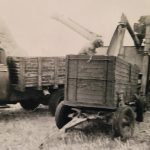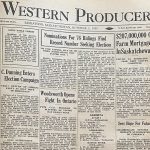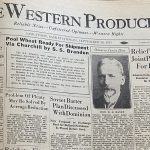For the next year, this column will mark The Western Producer’s 100th anniversary by taking a deep dive every week into a past issue of the paper. It can be a surprise for modern readers of The Western Producer to scan issues of the paper from the first half of the 1940s and see all […] Read more
Tag Archives WP100

‘Farming has changed so much’
A 92-year-old who retired at 85 but still helps out on the family farm when needed reflects on the changes he has seen
The first subscription to The Western Producer that Chris Heathcote remembers his household purchasing wasn’t with cash or cheque. “The first subscription for the paper was paid for by six laying hens,” Heathcote said about getting the Producer at his Craik, Sask., farmhouse 85 years ago. “That was in the Thirties, and we didn’t have […] Read more
Families preserved, conserved and recycled in wartime
These are the minimum daily requirements of the foods necessary to protect health:
For rural prairie families who had endured the crop failures, economic depression, unemployment and drought of the 1930s, the rationing, recycling and preserving that were demanded during the Second World War were not much different. With the declaration of war in 1939, there was an immediate demand for food, soldiers, workers and military supplies. Many […] Read more
A look back at a Massey Ferguson milestone
The company built a state-of-the-art plant in Ontario in the early 1960s to design and build a new line of combines
“Get up to date or go out of business.” That quote appeared in one of the many official news releases Massey Ferguson’s public relations people were handing out on June 9, 1964. It was the day of the grand opening of the company’s combine plant in Brantford, Ont., and the comment, more than any other, […] Read more
Rye bread continues to nurture loyal following
‘Winnipeg rye’ still enjoys an international reputation as a new generation of bakers works to keep old traditions alive
This is part of an ongoing series of stories exploring rye, the crop, as it becomes Rye, the whisky. The rich, spicy, humid smell of just-baked rye bread fills the busy shop front at Winnipeg’s City Bread on this lunch hour. Other stories in this series: More producers start growing rye as crop prepares for […] Read more
Look back at the Oct. 19, 1939, issue
For the next year, this column will mark The Western Producer’s 100th anniversary by taking a deep dive every week into a past issue of the paper. The Oct. 19, 1939, issue is the last of the five papers we will be looking at in this space that were published during the Dirty Thirties. It […] Read more

Sask. greenhouse co-operative was a unique employer
A 41-year-old documentary from the National Film Board of Canada is about more than a greenhouse business that provided jobs for 34 years to people who otherwise might have struggled to earn a living. “They had quite an adventure,” said Dave Fortman about his mother, Margaret, and her co-workers at the Churchill Park Greenhouse Co-op […] Read more

Look back at the Oct. 3, 1935, issue
For the next year, this column will mark The Western Producer’s 100th anniversary by taking a deep dive every week into a past issue of the paper. Politics was the name of the game in the Oct. 3, 1935 issue, which I suppose was to be expected, considering the country was in the middle of […] Read more

Trying to keep farm families fed in 1930s was a struggle
During the 1930s, an almost decade-long drought affected much of the Prairies along with infestations of grasshoppers, gophers and cutworms. With the lack of rain, the dry farmland blew away, creating terrible dust storms. A worldwide Depression, which led to a rapid decline in global trade and rising unemployment, occurred at the same time. Prairie […] Read more

Look back at the Sept. 28, 1933, issue
For the next year, this column will mark The Western Producer’s 100th anniversary by taking a deep dive every week into a past issue of the paper. We’re a third of the way through what is now called the Dirty Thirties, the climatic calamity that devastated prairie agriculture 90 years ago, but there’s little indication […] Read more



![One must remember that back [during World War II], The Western Producer might have been the only newspaper read on the farm. There was news on the radio, but if the Producer wasn’t informing isolated rural residents about the latest war developments, there was a good chance they wouldn’t know about them. | Bruce Dyck photo](https://static.producer.com/wp-content/uploads/2023/10/25161654/11-Oct-26-IMG_0385-150x150.jpg)


